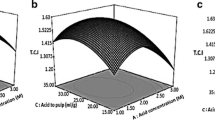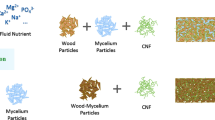Abstract
Self-bonding of air-dried undebarked cotton stalks during hot pressing in a closely fitting mold was studied. Advanced board-like green nanocomposites from ground undebarked cotton stalks were introduced for the first time in the present work. The dry forming process was adopted. Moderate molding pressure and temperature were selected and applied in a tight die, thus saving water and energy and avoiding the use of any binders to achieve an environment-friendly green product. Green nanocomposites having densities in the range of 1.27–1.29 g/cm3 and 1.03–1.06 g/cm3 were prepared. Particle size and cell wall morphological structure were found to play a major role in self-bonding. Properties of composites prepared from the fine fraction of cotton stalks were superior to those prepared from the cotton stalk coarse fraction at the same conditions. This is attributed—among other things—to the dominance of pith (parenchymal cells) in the fine fraction. Such cells possess a high lumen-to-cell wall ratio, which renders them more deformable under pressure, leading to more intercellular or interparticle bonding. Advanced binderless green nanocomposites having bending strength as high as 637 kg/cm2 and water absorption as low as 12.1 % were obtained from the ground undebarked cotton stalks. The results show clearly that the advanced green nanocomposite obtained by the dry forming process, without the addition of any binders, is superior to hardboard obtained from cotton stalks by the conventional wet web formation process. The mechanism of self-bonding is discussed.
Similar content being viewed by others
References
Adieb N (1973) Influence of chemical modification on wood and fiber board. Ph.D. thesis, Cairo University
EI-Meadawy S (1971) Pulping of cotton stalks. M.Sc. thesis Cairo University
Fahmy Y (1976) Cotton stalks as a fibrous source for fine paper and rayon. I. Bleached pulp for fine paper. Cell Chem Technol 10:723–735
Fahmy Y (1979) Cotton stalks as a fibrous source for fine paper and rayon. II. Dissolving pulp for viscose and rayon. Cell Chem Technol 13(3):385–390
Fahmy TYA (2007a) Introducing molasses as a new additive in papermaking. Tappi J 6(8):23
Fahmy TYA (2007b) Molasses as a new additive in papermaking: for high alpha-cellulose wood pulp. Prof Papermak 4(1):42
Fahmy TYA, Mobarak F (2008a) Vaccination of biological cellulose fibers with glucose: a gateway to novel nanocomposites. Int J Biol Macromol 42(1):52
Fahmy TYA, Mobarak F (2008b) Nanocomposites from natural cellulose fibers filled with kaolin in presence of sucrose. Carbohydr Polym 72(4):751
Fahmy TYA, Mobarak F (2009) Advanced nano-based manipulations of molasses in the cellulose and paper discipline: introducing a master cheap environmentally safe retention aid and strength promoter in papermaking. Carbohydr Polym 77(2):316
Fahmy TYA, Mobarak F (2011) Green nanotechnology: a short cut to beneficiation of natural fibers. Int J Biol Macromol 48(1):134
Fahmy Y, Mobarak F, Schweers W (1982) Pyrolysis of agricultural residues. Part II. Yield and chemical composition of tars and oils produced from cotton stalks and assessment of lignin structure. Cell Chem Technol 16:453–459
Fahmy TYA, Mobarak F, Fahmy Y, Fadl MH, El-Sakhawy M (2006) Nanocomposites from natural cellulose fibers incorporated with sucrose. Wood Sci Technol 40(1):77–86
Hashim K (2012) Properties of binderless particle board panels manufactured from oil palm biomass. Bioresources 7(1):1352–1365
Mobarak F (1983) Rapid continuous pyrolysis of cotton stalks for charcoal production. Holzforschung 37:251–254
Mobarak F, Fahmy Y (1977) Newsprint from cotton stalks. Indian Pulp Paper 32(5):15–22
Mobarak F, Nada A (1975) Fiberboard from exotic raw materials. II. Hardboard from undebarked cotton stalks. J Appl Chem Biotechnol 25:659–662
Mobarak F, Nada A, Fahmy Y (1975) Fiberboard from exotic raw materials. I. Hardboard from rice straw pulps. J Appl Chem Biotechnol 25:653–658
Mobarak F, Fahmy Y, Augustin H (1982) Binderless lignocellulose composite from bagasse and mechanism of self-bonding. Holzforschung 36(3):131–135
Runkel ROH (1951) Zur Kenntnis des thermoplastischen Verhaltens von Holz. I. Mitteilung. Holz als Roh- u. Werkstoff 9:41–53
Runkel ROH, Wilke KD (1951) Zur Kenntnis des thermoplastischen Verhaltens von Holz. II. Mitteilung. Holz Roh- u. Werkstoff 9:260–270
Runkel ROH, Witt H (1953) Zur Kenntnis des thermoplastischen Verhaltens von Holz. III. Mitteilung. Uber die wasser und alkoholloslichen Anteile von hitzeplastiziertem Holz. Holz Roh- und Werkstoff 11:457–461
Author information
Authors and Affiliations
Corresponding author
Rights and permissions
About this article
Cite this article
Fahmy, T.Y.A., Mobarak, F. Advanced binderless board-like green nanocomposites from undebarked cotton stalks and mechanism of self-bonding. Cellulose 20, 1453–1457 (2013). https://doi.org/10.1007/s10570-013-9911-9
Received:
Accepted:
Published:
Issue Date:
DOI: https://doi.org/10.1007/s10570-013-9911-9




